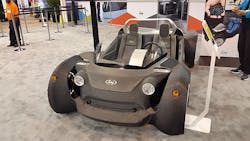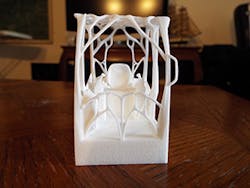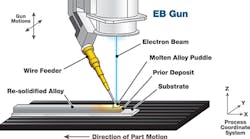The movie Back to the Future showed us cars hovering in air in an idea of what 2015 would look like. Now in 2016, we see our cars still bound to the earth. However, when the movie was made, in 1985, most of the materials in modern vehicles didn’t exist.
“About half the steel in cars being used today didn’t exist even 15 to 20 years ago,” says Dave Paratore, president and CEO for NanoSteel. New high-strength steels, along with composites and adhesives, are helping to reduce weight and increase strength in modern vehicles. While that might not seem extremely futuristic, it does show how innovation continues steadily—albeit sometime in the background—in the automotive arena. Today, for example, 3D printing is advancing the automotive industry and making vehicles stronger and lighter.
In 2014, Local Motors printed the first 3D-printed car from an ABS carbon-fiber blend (about 80/20 respectively) called Strati. Today, the company has three models and an autonomous electric-powered shuttle named Olli. In addition, Honda released a new version of the Micro-Commuter in October at CEATEC 2016 in Japan. A single-seater with about a 50-mile driving range, the body and majority of the panels on the Micro-Commuter are 3D printed. As exemplified by the Micro-Commuter, the main driver in 3D printing for vehicles is not printing the entire vehicle, but a move to 3D printing tooling and end-use parts. According to SmarTech, prototyping has only penetrated automotive prototyping by 15% to 20%. Ford, for example, has been 3D printing prototypes for over 20 years to decrease design time. Recently, the company joined others in investing in a new 3D printing technology to explore using it as a means for production.
Such moves are certainly helping to boost the value of this market. In a new report, SmarTech Publishing says that revenue in the 3D printing automotive market will hit $600 million by the end of this year. It estimates $2.3 billion in revenue by 2021. Yet there are still many naysayers asserting that the 3D printing of cars is just hype. Among the issues they point to is speed in manufacturing, which is of course critical to the automotive industry. It’s true: 3D printing is not known for speed. However, in December 2014, Ford started testing a pre-released version of the continuous liquid interface production (CLIP) offered by Carbon 3D.
The CLIP process is similar to digital light projection (DLP). However, the DLP vat container only lets light pass through it. Carbon 3D’s vat container, in contrast, allows light and oxygen to travel through the container (like a contact lens). This aids in the solidification process while decreasing build times. As a result of this approach, Carbon 3D claims that it can print 25 to 100 times faster than conventional 3D printing methods.
But can 3D printing move beyond prototyping right now? “3D printing for mass-production parts can be challenging,” says Lindsay Lewis, account manager at Synergeering. “I feel 3D printing will remain mostly valuable to lower-volume production. This might mean higher-end vehicles or military vehicles. Also, there is a new trend in the automotive industry for re-manufacturing. This is to reduce inventory or generate parts that OEMs may not be producing or storing anymore. Usually, re-manufacturing will be for vehicles that are older, say 15 to 20 years.
“Overall, you have to weigh the value,” add Lewis. “You have to ask: How many parts are you going to make and what’s the tooling cost versus 3D printing? The bottom line is cost and speed.”
Driving Toward 3D Printing
With the bottom line in mind, 3D printing isn’t ideal for all parts. However, parts aren’t the only way that 3D printing can help the automotive industry. “More companies are adopting 3D printing for jigs and fixtures,” says Ron Clemons, director of business development for Stratasys Direct Manufacturing. “3D printing jigs and fixtures can lower costs, provide lighter and more ergonomic tools, and more. Furthermore, it has shown a consistent reduction in lead-time by 40% to 90% and cost reduction up to 60%. 3D printing tooling also allows design teams to save time because they can be more responsive with the ability to create one-off custom components.”
Lightweight, ergonomic tools can increase repeatability. They also can help the automotive field deal with increased regulations. Large fines from the Corporate Average Fuel Economy (CAFE) are steadily increasing miles per gallon across a company’s fleet. Demand for safety is increasing, too. About 20 years ago, the roof-strength requirement to resist rollover crush was roughly the weight of the vehicle. Today, rollover strength is about four times the gross vehicle weight. Optimizing the maximum strength with minimum weight and material is possible with a process called topographical optimization (TO), which is available in multiple CAD packages. TO is virtually impossible to manufacture with traditional methods, but 3D printing has the potential to handle complex geometries in a minimal waste process with lightweight materials.
TO is just one benefit offered by the 3D printing process. Another advantage is that assemblies can be combined into a single printed part. This can reduce assembly time and produce a higher-quality part. For complex automotive interiors, 3D Systems has shown that a large build space—with a selective laser sintering process—can allow the quick, seamless 3D printing of big and/or complex end-use interior parts. In addition, material selection can offer a different feel and texture.
While early adopters found use in small, complex parts, the automotive industry is finding many new uses for this technology. Even something as small and simple as a grommet in the door of the Ford Focus Electric showed improvement with 3D printing. Using the Carbon 3D process, grommets were made in one-third the time and the material properties were closer to the final desired properties.
Moving to Metal
Although the CLIP process from Carbon 3D has received a lot of attention, there are many different types of 3D printing that can be applied to automotive parts and manufacturing. While different types of plastic printing are grabbing headlines, some companies are looking at large metal parts. “When looking at the $90-billion-plus global market for manufacturing technology products, less than $1 billion of that is currently being derived from 3D metal printers,” says David Burns, retired CEO of ExOne. “Within five years, there could be demand for as much as $10 billion from these machines, and the question is: What company is going to deliver a technology that widens the audience?”
There has been an increased demand and interest in the 3D printing of large metal parts. At the International Manufacturing Technology Show (IMTS) this past September, Oakridge National Laboratory (ORNL) presented several full-size, 3D-printed vehicles and even a printed living space. “Next year at CONEXPO-CON, we will be printing an excavator live at the show,” says Lonnie Love, group leader for the manufacturing system research group at ORNL. Large metal parts might not be completely justifiable or economical at this time. Given the amount of research and development by groups like ORNL, however, it might only be a matter of time until 3D printing finds a home in many parts of an average family vehicle.
Metal printing will certainly aid that adoption. In a relatively new process, for example, liquid metal 3D printing is now becoming available. A father-son operation out of Buffalo, N.Y., called Vader Systems is using a Gauss gun-inspired magnetohydrodynamic print head they are calling magneto jet. This allows control of not only where the droplets are being placed, but even the size of the droplet. “Our process can print aluminum at a deposition rate of one pound per hour at very low cost,” says CEO Scott Vader. “In a couple of years, we will be printing at rates that will rival conventional manufacturing processes. In addition, we will increase our print head temperature to allow printing of steels and other high temperature metals.”
Recently, Rochester Institute of technology announced it would acquire Vader Systems. The print technology will become part of the school’s AMPrint Center. The center’s goal is to advance two Finger Lake industries—printing and imaging.
For now, powder bed and electron-beam printing seem to work well for the metal printing industry. Companies such as Sciaky use a wire-feed electron-beam process that is similar to welding layers of metal in a vacuum. The welding approach prevents the formation of slang and corrosion, allowing for better part density and strength. A Sciaky representative at IMTS said printing in a vacuum is cheaper than filling the chamber with inert gases each print.
“For the powder-bed fusion processes for printing of metal,” Dunham says, “I think we’ll see a lot of demand from the auto industry in aluminum alloys and stainless steels for printing of functional prototypes at first, along with hard tools. However, in the next five years or so, this process could produce production parts.”
With multiple experts saying vehicles may have more and more 3D printed parts over the next five years, the new standard from ASTM International is certainly welcome. In early October, the global standards development organization announced, “Directed energy deposition, an important metal additive manufacturing process, is now covered in an ASTM International standard. The standard (soon to be published as F3187, Guide for Directed Energy Deposition of Metals) was developed by ASTM International Committee F42 on Additive Manufacturing Technologies.” It focuses on setup, application, documentation, and more. While engineers have been asking for standards, however, this specific one doesn’t discuss much about materials.
Materials
“Efforts to print aluminum alloys are being driven to a high degree by the auto industry,” says Dunham. “Traditional aluminum alloys can be a challenge for the metal powder bed processes, so much of aluminum printing are in alloys that are not familiar to the auto industry. This limits its popularity somewhat.”
Composites using carbon fiber and glass fiber reinforcement are improving strength on some 3D printable plastics. This is making them more attractive to the automotive market. However, this can bring up more challenges. “The [automotive] industry isn't using a ton of composites just yet,” said Dunham. “The demand to develop better composite processing solutions for high volume auto manufacturing is definitely there. High volume isn't typically something that additive has done well in the past, but some interesting things are being worked on in that regard, such as the large format, near-net capabilities of thermoplastic composite extrusion. Dunham notes, “The auto industry in general can definitely be credited with helping push the 3D printing industry towards composite solutions at a faster rate over the last five years.”
According to the SmarTech report, consumption of 3D printing materials by the automotive industry will reach around $530 million by 2021. An important factor will be the rise of composite materials. One of the challenges when considering materials for a vehicle is that properties change depending on the environment. Vehicles undergo many environmental changes through their lifecycles, and vehicles are distributed to a large range of environments. Some plastics might not be rated for high temperature. This isn’t limited to the engine compartment. If it is a sunny day, a vehicle’s interior temperature can exceed 100° F. This may cause chain scission and premature degradation in some polymers.
While composites and high-strength polymers help increase a materials operational temperature, it often makes manufacturing more difficult or takes additional energy to process. In addition, blends and composites can make conformity and recycling a challenge. So ultimately, while 3D printing will show growth in the automotive industry, there are many challenges and no plans to produce a hover car. However, the Jetsons—a cartoon TV family from the early 1960s, but set in 2062—had hover cars. So engineers have some time to figure it out.









